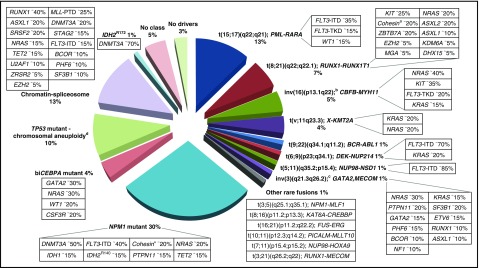Figure 1.
Molecular classes of AML and concurrent gene mutations in adult patients up to the age of ∼65 years. Class definition is based on the study by Papaemmanuil et al.37 For each AML class denoted in the pie chart, frequent co-occurring mutations are shown in the respective boxes. Data on the frequency of genetic lesions are compiled from the databases of the British Medical Research Council (MRC), the German-Austrian AML Study Group (AMLSG), and from selected studies.37,87,88,299 a indicates cohesin genes including RAD21 (∼10%), SMC1A (∼5%), and SMC3 (∼5%); b, inv(16)(p13.1q22) or t(16;16)(p13.1;q22); CBFB-MYH11; c, inv(3)(q21.3q26.2) or t(3;3)(q21.3;q26.2); GATA2,MECOM(EVI1); and d, TP53 mutations are found in ∼45%, and complex karyotypes in ∼70% of this class. The structure of the pie chart is adapted from Grimwade et al,50 generated by Adam Ivey (King’s College London, London, United Kingdom).

